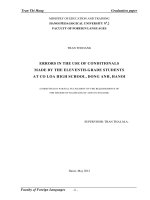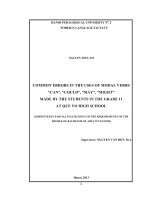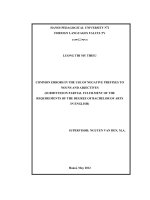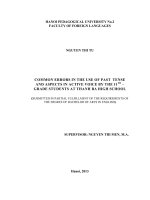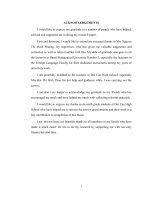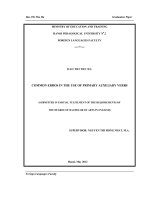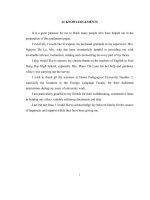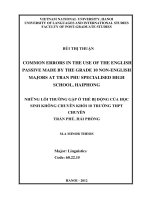Common errors in the use of English articles made by first-year students at Hung Yen industrial college
Bạn đang xem bản rút gọn của tài liệu. Xem và tải ngay bản đầy đủ của tài liệu tại đây (1.39 MB, 53 trang )
iii
ABSTRACT
This study focuses on the analysis of errors in the use of English articles made by
first-year students at Hung Yen Industrial College with an aim to recommend some
selected implications for better teaching of English articles. The analysis was based
on the data collected from two tests: a free-response test, writing a composition and
a multichoice test provided by 90 non-major first-year students of Hung Yen
Industrial college. Errors were described and classified according to linguistic
category and strategies employed by the students. The greatest frequency of errors
occured in the definite article in both tests. The omissions of both definite and
indefinite articles were most found in the compositions but the wrong selections of
definite article instead of the indefinite in the multi-choice test. Explanations for the
causes of the errors were done: interlingual or intralingual and developmental
causes. Suggestions for improvement in teaching English articles are offered based
on the findings.
iv
LIST OF ABBREVIATIONS AND SYMBOLS
E.g.
For example
i.e.
That is
L1
First language
L2
Second language
EFL
English as a foreign language
Ø
Zero article
v
LIST OF TABLES
Table 1: Summary of English articles (p.5)
Table 2: Bickerton’s semantic table for noun phrase reference (p.9)
Table 3: General information of the writing corpus (p.25)
Table 4: Frequencies of articles supplied in the written work by article type (26)
Table 5: Non-pass and pass students of Test 2 (p.26)
Table 6: Distribution of choices by the students in Test 2 (p.27)
Table 7: Distribution of explanations on the right choices by the students in Task 1
(p.27)
Table 8: Errors classified according to linguistic categories (p.29)
Table 9: Errors classified according to the strategies employed by the students
(p.30)
Table 10: Strategies and causes of errors (p.36)
Table 11: Interlingual versus intralingual and developmental errors (p.37)
vi
TABLE OF CONTENTS
DECLARATION OF ORIGINALITY ............................................................................... i
ACKNOWLEDGEMENTS ............................................................................................... ii
ABSTRACT....................................................................................................................... iii
LIST OF ABBREVIATIONS AND SYMBOLS .............................................................. iv
LIST OF TABLES ............................................................................................................ v
TABLE OF CONTENTS................................................................................................... vi
PART A: INTRODUCTION
1. Rationale for the study ........................................................................................ 1
2. Aims of the study ................................................................................................ 2
3. Research questions .............................................................................................. 2
4. Scope of the study ............................................................................................... 2
5. Methods of the study ........................................................................................... 3
6. Significance of the study ..................................................................................... 3
7. Design of the study.............................................................................................. 3
PART B: DEVELOPMENT
CHAPTER 1: LITERATURE REVIEW
1.1. An overview of English article system ............................................................ 4
1.1.1. Definitions of English article .................................................................. 4
1.1.2. Types of English articles ......................................................................... 4
1.1.2.1. Definite article ............................................................................. 5
1.1.2.2. Indefinite articles ......................................................................... 6
1.1.2.3. Zero article .................................................................................. 7
1.1.3. Usage of English articles ......................................................................... 8
1.2. The determiners in Vietnamese language ....................................................... 10
1.3. Error and error analysis ................................................................................... 12
1.3.1. The notions of errors in language learning ............................................ 12
1.3.2. Classifications of errors.......................................................................... 13
1.3.3. Error analysis ......................................................................................... 14
vii
1.3.3.1. Definitions ................................................................................... 14
1.3.3.2. Significance of error analysis ..................................................... 15
1.3.3.3. Stages in error analysis ............................................................... 16
1.4. Causes of errors in second language learning ................................................. 17
1.4.1. Causes of interlingual errors .................................................................. 17
1.4.2. Causes of intralingual and developmental errors ................................... 18
CHAPTER 2: RESEARCH METHODOLOGY
2.1. Setting of the study.......................................................................................... 21
2.2. Participants ...................................................................................................... 22
2.3. Instruments of data collection ......................................................................... 23
2.4. Data collection procedures .............................................................................. 23
2.5. Methods of data analysis ................................................................................. 24
CHAPTER 3: FINDINGS, DISCUSSIONS AND RECOMMENDATIONS
3.1. Findings and discussions ................................................................................. 25
3.1.1. General evaluation of the students’ performance .................................. 25
3.1.2. Recognition of errors.............................................................................. 28
3.1.3. Description of errors .............................................................................. 28
3.1.4. Explanation of errors .............................................................................. 31
3.2. Recommendations ........................................................................................... 37
3.2.1. Recommendations for instructional materials........................................ 37
3.2.2. Recommendations for teachers’ presentation ........................................ 38
PART C: CONCLUSION
1. Conclusions ........................................................................................................ 40
2. Limitations and suggestions for further study.................................................... 41
REFERENCES................................................................................................................ 42
APPENDIX .....................................................................................................................VIII
MULTI-CHOICE TEST ...............................................................................................VIII
-1-
PART A: INTRODUCTION
1. RATIONALE FOR THE STUDY
The English article system is one of the most difficult aspects of English grammar for
students of English as a second language to understand. English articles occur very
frequently and incorrect use may affect communication negatively. Also an L2 writer
may prefer to be accurate, when he/she has to write. Master (2002) attributes this
difficulty to three facts about the article system: First, the English articles, the, a and
zero, are the most commonly used words in English, making constant rule application
difficult over a long discourse; Second, function words are often spoken with such
weak stress that they are inaudible and consequently are very difficult for non-native
speakers to discern, which affects the availability of input in the spoken mode; and
third, the article system stacks multiple functions onto a single morpheme, which
constitutes a considerable burden for the learner who usually looks for a one-to-one
correspondence between form and function, especially in the early stages of language
learning.
In addition, because they rarely carry significant information, they can usually be
deleted in telegraphic speech, including telegrams and newspaper headlines. Thus,
unlike content words, function words are generally overlooked by learners when
processing language primarily for meaning. According to Pienemann (1998), the
difficulty of the meaning expressed by an article is determined by the novelty and
abstractness of the concept, not to mention learners’ changing hypotheses about article
usage at different stages in interlanguage development and the potential influence of
the native language which may further complicate the task.
The idea of doing my research came from the following reasons. First, researchers such
as Newman (1977, cited in Master, 1988) and Barry Lush (2002) analyzed the
composition errors of EFL learners and found that of all error types, the most common
were related to definite and indefinite articles.
-2-
Second, the English article system is so difficult to acquire for students with article-less
languages like Vietnamese as their first language. It is also understood that these errors
are mostly caused by the fact that no such independent grammatical category as the
article exists in Vietnamese on which the learners could lean when learning the use of
the English article system. This, of course, holds true generally, but we still come up
against the problem of which parts of the English article system are especially difficult
for Vietnamese learners to understand and learn.
2. AIMS OF THE STUDY
This study is carried out with the aims:
To identify the students’ common types of error in using English articles.
To find out the causes of error committed by Hung Yen Industrial College’s
students when learning and using English articles.
To work out possible solutions to the problems identified.
3. RESEARCH QUESTIONS
In order to achieve the above mentioned aims, the study will be conducted to answer
the three following research questions:
1) What are the common types of article errors made by first-year students at
Hung Yen Industrial College?
2) What are the possible causes of the errors the students make in the use of
English articles?
3) What are the recommendations for the teachers to teach English articles
effectively?
4. SCOPE OF THE STUDY
The research will deal with errors in the use of English articles on the first-year student
writings at Hung Yen Industrial College. The subjects selected for this study are 90
general EFL learners.
-3-
5. METHODS OF THE STUDY
In order to complete the paper, the main research methods employed are:
-
Statistical methods are used to find out and classify the learners’ errors
-
Descriptive methods are used to describe the actual errors committed by the
learners
6. SIGNIFICANCE OF THE STUDY
The study will be useful not only to the author and her colleagues in improving the
teaching quality, but students will also benefit from it. The result of the study will serve
as a foundation for the possible solutions to students’ errors in using English articles.
Furthermore, the study will make some contribution to the field of teaching
methodology.
7. DESIGN OF THE STUDY
The study has three main parts as follows: Part A provides a brief introduction to the
issue and an overview of the paper. Part B includes three chapters, namely Literature
Review (Chapter 1), Research Methodology (Chapter 2) and Data Analysis and
Discussion (Chapter 3). In greater details, Chapter 1 reviews the theoretical
backgrounds to English article system, error and error analysis in second language
learning. Chapter 2 describes the methods used to carry out the study. It also includes
an overview of the context of the study. Chapter 3 presents and analyzes the data
collected, and offers possible solutions to errors made by students at Hung Yen
Industrial College. Some suggestions for the betterment of teaching and learning
English article system are also provided. Part C summarizes the main issues so far
touched upon in the research, the limitations of the research and some suggestions for
further studies. Following the chapters are the references and one appendix.
-4-
PART B: DEVELOPMENT
CHAPTER 1: LITERATURE REVIEW
1.1. An overview of English article system
The article in English has always been considered one of the most formidable problems to
overcome in teaching English grammar to foreigners and its misuse is one of the most
evident grammatical signs that a person is not a native speaker of English. In this part, I
will present an overview of English article system.
1.1.1. Definitions of English article
An important subset of adjectives in English is the determiner, a category of words that
indicate which noun is being discussed. The determiner in English consists of articles (a/an,
the), possessives (my, your, their, etc), demonstratives (this, that..), numerals (three,
first…) and a few quantifiers (some, many…).
According to Richards and Schmidt (2002), determiner is a word which is used with a
noun and which limits the meaning of the noun in some way. The most common kind of
determiner in English is the article. And Alexander (1998) defines that “articles are
determiners which affect the meaning of the noun, and make it clearer by showing which
particular thing we are referring to” (p.55).
1.1.2. Types of English articles
In Thomson and Martinet (1986:15-22), English articles are classified into two types:
definite article the and indefinite article a/an. However, Quirk and Greenbaum (1987) adds
one more type, that is zero article Ø. Yotsukura (1970) seems to be the first person who
suggests adding another category beside the zero article. So English articles include a/an, the
and Ø (the null or zero marker). The two categories of the article are traditionally called
indefinite and definite articles. Singular count nouns take a or an as indefinite articles.
Plural nouns and non-count nouns take as their indefinite article. All categories of nouns
take the as the definite marker. This system is summarized in the following table:
-5-
Singular
INDEFINITE ARTICLE
DEFINITE ARTICLE
a/ an
The
Ø
The
Ø
The
Count noun
Plural
Non-count noun
Table 1: Summary of English articles
According to Whitman (1974), “thinking about the articles in such terms as: A/an is the
indefinite article and the is the definite article” (p.253) is considered a misunderstanding or
misconception. He also explains that
The misconception involved lies in thinking that a/an and the are essentially the
same thing (that is, “articles”), differing only along a dimension of “definiteness/
indefiniteness” or “specificity/ nonspecificity”. A/an and the are, in fact, entirely
different syntactic entities, quite unrelated to each other except for that fact that
both occur within the same general structure (p254).
However, for reasons of conformity with other grammarians and textbooks, the
terminology “indefinite” or “definite” will be kept. For example, if we say, ‘I have a book
you may be interested in,” we are referring to a definite, specific book. Nonetheless, we
use the indefinite article a to signal that the book is not known by the listener.
1.1.2.1. Definite article
“The definite article the never varies in form whether it refers to people or things, singular
or plural” (Alexander, 1998:55).
(1)
a. Ann is in the garden. (the garden of this house)
b. Please pass the wine. (the wine on the table)
(Thomson and Martinet, 1998:19)
According to Halliday and Hasan,
The definite article has no content. It merely indicates that the item in
question is specific and identifiable; that somewhere the information
necessary for identifying it is recoverable (1976:71).
-6-
The definite article indicates a referent that familiar in the general knowledge shared by the
speaker and the listener (s), whilst the zero article refers to something generic. The generic use
of the noun leaves out the definite article.
(2)
a. I don’t like surprises.
b. The surprises they had were fantastic.
In the example above, the noun surprises in the first sentence is referring to generic
surprises as the speaker does not designate what kind of surprises. Consequently, the noun
surprises does not involve a definite article the. In the second sentence, the noun surprises
is referring to specific ‘surprises”. Thus, the noun does require a definite article.
1.1.2.2. Indefinite articles
Quirk et al. (1985:272) give this definition:
The indefinite article is notionally the “unmarked” article in the sense that it is used (for
singular count nouns) where the conditions for the use of the do not obtain. That is, a/an X
will be used where the reference of X is not uniquely identifiable in the shared knowledge
of speaker and hearer.
The indefinite article (a/an) occurs in an indefinite singular noun phrase environment to
denote the countability of the noun phrase. This special syntactic distribution of a, however,
signals an important conceptual meaning such as individuating or particularising. The basic
core function of a can be stated as: to introduce a single indefinite, individuated entity to
the wider general set of entities denoted by the head noun. The use of a indicates that there
must exist other referents of the same general set that are not included in the particular act
of reference. This function is often called its instantial use or specimen of a category use.
(3)
a. I need a visa
b. A car must be insured.
(Thomson and Martinet, 1998:15)
A more process-oriented definition is that “the indefinite article acts as an instruction to the
listener not to bother to search for that referent-for a variety of reasons” (Gallaway, 1987,
cited in Beaumont and Gallaway, 1994:163).
-7-
1.1.2.3. Zero article
Although the term “zero article” traditionally refers to any instance in which a noun
requires no article, the researchers (Yotsukura, 1970; Celce-Murcia & Larsen-Freeman,
1999) divide the zero article into two types: zero and null. To Yotsukura, there is
distributional evidence suggesting a form other than the zero article. By using a postmodifying restrictive relative clause test, she discovered that the second zero form is found
before singular proper nouns and some common nouns. Celce-Murcia & Larsen-Freeman
also found that the zero article occurs with nonspecific or generic noncount and plural
nouns, such as water and cats. The null article occurs with certain singular count and
proper nouns, such as Chicago and lunch. Quirk et al. (1985: 246) describe a proper noun
like Marjon as having “no article” and a common noun like music as having a “zero
article”.
Chesterman suggests using the term the null form for the second zero article. Let us
consider examples such as the following from Chesterman (1991:17).
(4)
a. * I like London that the tourists see.
b. I like the London that the tourists see.
c. I like cheese that is made of goat’s milk.
(5)
a. Word has come that the Pope has died.
b. *Word that came yesterday was that the Pope has died.
c. The word that came yesterday was that the Pope has died.
(6)
a. What about question seven?
b. *What about question seven you answered before, then?
c. What about the question seven you answered before, then?
(7)
a. Breakfast is ready.
b. *Breakfast you asked for is ready.
c. The breakfast you asked for is ready.
Through a post-modifying restrictive clause test, it can be seen that there is a difference
between a proper noun such as London (with a presumed null article) and a common noun
such as cheese (with a presumed zero article). A noun with a zero article can be used with a
restrictive clause, but a noun with the null form cannot. In order to ‘identify’ the proper
nouns in (4b), (5c), (6c), and (7c), the should be used instead. Master (1997) supports
-8-
Chesterman when he regards the null form as the null article. To him, the null article is the
most definite of the articles.
1.1.3. Usage of English articles
“Articles are the most commonly used words in English, and yet their usage is in fact
surprisingly complex. Part of the complexity can be attributed to the fact that the English
article system does not consist of one-to-one form and meaning relationships. This
complexity poses a number of challenges for L2 learners of English” (Andersen 1984,
cited in Butler, 2002:452).
Hok, R. (1970) summarizes the rules for using the article as follows:
“1. Count nouns in the singular must use the or a.
2. Non-count nouns and plural count nouns may use the or Ø.
3. The choice between the, a, Ø depends on the speaker’s position (i.e., the
category he is working from)” (p.234).
The English article system has long been a subject of interest for linguists, given its
complex usage and the difficulty involved in analyzing it. According to Bickerton (1981,
cited in Liu & Gleason, 2002),
The use of the English articles—a, the, and zero—is governed by the semantic
function of the noun phrase (NP) in discourse. The classification of the semantic
function of an NP is then determined, he argued, by two binary discourse features: (a)
whether a noun is a specific referent (±SR), and (b) whether the hearer knows the
referent (±HK). Based on such an analysis, NPs fall into four major semantic types
(p.2).
The classification is summarized in the following table
-9-
Noun phrase reference
Article usage
1. [−SR, +HK]
Generics
2. [+SR, +HK]
Unique, previously mentioned, or the
the, a, Ø
physically present referents
3. [+SR, −HK]
First-mention NPs, or NPs
following existential ‘has/have’ or
‘there is/are’
a, Ø
4. [−SR, −HK]
Equative NPs, or NPs in negation, a, Ø
question, or irrealis mode
Table 2: Bickerton’s semantic table for noun phrase reference
This classification illustrates clearly that the four semantic types of NPs each have
different discourse and referential constraints and thus call for the selection of a specific
article or articles from among a, the, and zero to mark these constraints. It is the knowledge
of the semantic types of NPs and the article (s) used with each type that enables English
speakers and writers to mark the NPs in discourse with the appropriate articles.
Quirk and Greenbaum’s classification of usage types (1987) has been well known and
been frequently cited. Their classification is based on notions of reference and genericity:
specific reference and generic reference. From a language teaching perspective, this
classification has produced lots of ‘detailed rules’ which can be generalized and re-categorized.
According to Quirk and Greenbaum (1987:67-80), the three basic functions of the article
are to express: (a) specific reference, (b) generic reference, and (c) unique reference.
Specific reference deals with the most important aspect of the article, since it includes the
functions of the articles as a discourse referent (e.g. A lion and two tigers are sleeping in
the cage). The reference is specific, since we have in mind specific specimens of the class
“tiger”. (Quirk and Greenbaum, 1987:68-76). New information is introduced to the reader
in sentence-final position in English. New information is thus marked with an indefinite
article, and when the information has been introduced to the reader, the given information
is placed in sentence-non-final position and marked with the definite article.
Quirk and Greenbaum (1987:68) states that generic reference is used to denote what is
normal or typical for members of a class (e.g. Tigers are dangerous animals). The reference
-10-
is generic, since we are thinking of the class “tiger’ without special reference to specific
tigers.
Whitman (1974) makes a clear distinction between generic uses of a/an and the. “Generic
a/an refers to a singular examples”, while “generic the calls forth an abstract median, the
mid point of the entire class”. He illustrates with the following examples:
(8)
A mouse is smaller than a rat.
The mouse is smaller than the rat.
A mouse is going to be fairly representative of all mice. The mouse in (8) is the abstract
average mouse. The generic the is abstract, while a/an is not. The researcher also
concludes that “generic articles may be used only with countable nouns” because “a
representative sample and a median point both imply differentiability, which is not a
characteristic property of mass and abstract nouns” (p258).
Generic sentences are individual, contextually independent. They are a way of making
generalizations, a way of expressing general truths. The definite generic article refers to a
whole class and the indefinite and zero articles refer to the individuals within a group.
Names possess unique reference. Quirk and Greenbaum (1987:76) maintain that “names
have unique reference”, because they do not share the characteristics of common nouns,
lacking article contrast in particular. The difference between common and proper nouns is
that the unique reference of names has been institutionalized (e.g. during Easter, during the
Easter of that year, Shakespeare, the young Shakespeare). When the names have restrictive
modification to give a partitive meaning to the name, proper nouns take the definite article.
Unique reference requires the shortest scope of investigation, because it can be easily
studied as a part of proper name formation.
1.2. The determiners in Vietnamese language
With respect to Vietnamese determiners, linguists have been inclined to agree that
Vietnamese has an article system which can partly be compared to that in English
(Nguyễn Tài Cẩn 1975; Đinh Văn Đức 1986). According to Nguyễn Tài Cẩn (1975) and
Đinh Văn Đức (1986), Vietnamese has four determiners: những, các (plural markers), một
-11-
(=a/one), null-form and zero article. However, some other linguists do not agree on
categorizing những and các as articles, but consider them numerals. Cao Xuân Hạo (1999)
still considers một, zero, những, and các quantifiers. In this study, I will use the term
determiner for what some linguists call articles. This presentation will reveal some
difficulties Vietnamese learners may encounter when acquiring the English article system.
Một
Một (a), derive from the numeral một (one), is an indefinite determiner in Vietnamese. Một
is quite similar to a in English in terms of non-definite and specific use.
(9)
Một
tách cà phê
A/one
cup coffee
“A cup of coffee.”
However, một N does not seem to be an equivalent of a+ N in English with respect to
predicate nominative constructions and generic use.
(10)
Ông ấy là
chính trị gia.
Ông ấy là một chính trị gia.
He
is
a
politician.
Hence, the use of the indefinite article in a predicate nominative construction is expected to
be a potential difficulty for Vietnamese learners.
Zero article
(11) Ở chợ trời đang có bán Ø đồ đạc và Ø quần áo đấy. Ø Đồ đạc thì giá cũng phải chăng
còn Ø quần áo thì rất rẻ. (Ø Furniture and Ø clothing are being sold at the flea market. The
furniture is reasonably priced, and the clothing is cheap.)
In example (11), the uncountable nouns furniture and clothing when first mentioned are
not preceded by a determiner. When they are repeated the second time, they must be
preceded by the definite article The. Whereas, in Vietnamese, no determiner is used in both
cases.
Những/ Các
-12-
Những and các are literally plural markers. They are used with count nouns to mark
plurality.
(12)
Những vì sao (the stars)
Các vì sao (the stars)
However, they are a little different from the.
(13) Phía sân khấu là một nhóm các nhạc công. Những nhạc công đó chơi nhiều loại nhạc
cụ phương đông. (Behind the screen was a group of Ø musicians. The musicians played
various oriental instruments.)
In the above example, the first time the word musicians appear, they are not preceded by
determiners, because the thing referred have not been mentioned previously. The second
time the word musicians appear, they are preceded by the, since the thing have already
been mentioned. However, in Vietnamese, Những/ Các appear whenever nouns are plural.
Both English and Vietnamese have count and non-count nouns, but English must mark for
plural whereas Vietnamese does not. Hence it can be expected that there is some
systematicity to the errors made by Vietnamese learners, but that problems may occur with
all articles in English.
1.3. Error and error analysis
1.3.1. The notions of errors in language learning
A number of experts in linguistics have presented numerous notions of error.
Norrish (1992:7) calls “a systematic deviation when a learner has not learnt something and
consistently gets it wrong, an error”, while Corder (1992) maintains that errors are
systematic and consistent deviances characteristic of the learner’s linguistic system at a
given stage of learning. “The learner’s errors are themselves systematic” (p.24).
“Systematic deviance” is the key word in these definitions. The phrase can be interpreted
that when a learner of English as second or foreign language makes an error systematically,
it is because he has not learnt the correct form. The systematic errors may be looked upon
as rule-governed for they follow the rules of whatever grammar the learner has.
-13-
Richards and Schmidt (2002) has a clearer definition that “error is the use of a
linguistic item (e.g. a word, a grammatical item, a speech act, etc) in a way which a fluent
or native speaker of the language regards as showing faulty or incomplete learning”
(p.184). it means that errors show what strategies the learners are using to acquire a
language.
There is a common consensus of opinion between Norrish (1992) and Jain (1992)
on the role of errors in teaching and learning a language. Norrish views “the error itself
may actually be a necessary part of learning a language” (p.6). Jain assumes that “the
second language learners’ errors are potentially important for the understanding of the
processes of second language acquisition” (p.189) and “errors would help determine which
areas in the learner’s English need more attention and what type of attention” (p.207).
1.3.2. Classifications of errors
Learners’ errors are usually classified in different categories. Burt (1975) made a
distinction between “global” and “local” errors. Global errors hinder communication and
they prevent the learner from comprehending some aspects of the message. Local errors
only affect a single element of a sentence, but do not prevent a message from being heard
(pp56-57). The global/ local distinction is the most pervasive criterion for determining the
communicative importance of errors.
According to Tomiyana (1980), “Errors can be categorized into three different
types: 1) omission of the item where it is obligatory (e.g. ‘Put book on table’), 2) insertion
of the item where it should not occur (e.g. ‘He lives in the Manchester), and 3) wrong
choice of the item (e.g. ‘Choose the cake from the plate’)” (p.72). Although the types of
errors identified by Tomiyana can provide an idea of the problems that students have
encountered in using the articles, the way of categorizing the errors (i.e. a surface strategy
taxonomy) gives little information on the noun phrase environments where learners make
errors nor how learners acquire the articles.
Richards (1992:173) proposes a three-way classification of errors:
(1) interlingual errors
(2) intralingual errors
-14-
(3) developmental errors
The interlingual errors are those caused by the influence of the learner’s mother
tongue on his production of the target language in presumably those areas where the
languages clearly differ.
The intralingual errors are those originating within the structure of English itself.
Complex rule-learning behavior is typically characterized by overgeneralization,
incomplete application of rules, and failure to learn conditions for rule application. When
the complexity of English structure encourages such learning problems, all learners,
regardless of background language, tend to commit similar errors.
The developmental errors reflect the strategies by which the learner acquires the
language. These errors show that the learner—oftentimes completely independent of his
native language—is making false hypotheses about the target language based on limited
exposure to it. A major justification for labeling an error as developmental comes from
noting similarities to errors produced by children who are acquiring the target language as
their mother tongue.
The author finds Tomiyana’s classification the way to categorize or describe the
errors and Richards’ the way to explain causes of errors made by the learners. Because
Richards’ does reflect the process of making errors.
1.3.3. Error analysis
1.3.3.1. Definitions
In the late 1960s, error analysis emerged and subsequently became the optimal
choice over contrastive analysis. This does not imply a complete rejection of contrastive
analysis; it remains foundational since it gave way to error analysis. But error analysis
reveals a wider dimension of likely errors rather than monopolizing it in one dimension as
in contrastive analysis.
Brown (2000:166) states that error analysis is the fact that learners do make errors
and that these errors can be observed, analyzed and classified to reveal something of the
-15-
system operating within the learners. The purpose is to show some problems faced by the
students. It is a key to understand the process of second or foreign language acquisition.
According to Richards and Schmidt (2002), “error analysis is the study and analysis
of the errors made by second and foreign language learners.” “Error analysis may be
carried out in order to (a) find out how well someone knows a language, (b) find out how a
person learns a language, and (c) obtain information on common difficulties in language
learning, as an aid in teaching or in the preparation of teaching materials” (pp.184-185).
From the above definitions, error analysis can be understood as a methodology to
identify, classify and interpret or describe the errors made by someone in speaking or in
writing in English.
1.3.3.2. Significance of error analysis
Whenever a language is learnt or acquired one is faced with the problem of errors.
Errors are an inevitable feature of learning. According to Corder (1992a), errors reveal the
knowledge of the learner of the target language at any point in its development. “The
learner’s errors are evidence of this system” (p.24) and the investigation of the language of
second language learners would rely heavily on error analysis (1992b:165). “There could
be no reason to engage in error analysis unless it served… to elucidate what and how a
learner learns when he studies a second language” (Corder, 1992b:169).
The study of errors takes on great significance in the field of second language
learning. Corder (1992a:25) gives three reasons for this significance. First, errors
committed by learners should not be viewed as evidence of failure. They should, on the
contrary, be viewed as a sign of their learning progress. Second, they serve as insights into
how a language is learnt. Third, they are seen as devices by which learners can find out the
rules of the target language, which can be deduced from feedback on their errors.
Having the same view on the importance of error analysis, Norrish (1992:80)
assumes that “an error analysis can give a picture of the type of difficulty learners are
experiencing. If carried out on a large scale, such a survey can be helpful in drawing up a
curriculum. For the class teacher, an error analysis can give useful information about a new
-16-
class”. It provides valuable insight into the language learning process. It helps the teachers
infer how much the students have learnt. It also gives an indication as to whether they are
ready to learn what the teacher wants to teach them next. Thus a lack of fit between the
learner’s needs and the items taught could be avoided. By analyzing their errors one could
build up a picture of the features of language which cause the learning problems. Once
their problems are understood in the right perspective remedial measures could be thought
of. An important part of the teachers’ job is to undertake a systematic analysis of learners’
errors. Error analysis helps reconstruct stages in language learning, design teaching method
and individualize language instruction.
It can be concluded that in the field of methodology, “the study of learners’
errors would assume the role it already plays in the study of child language acquisition”
(Corder, 1992a:24). Thus, error analysis is hailed as more practical and realistic, and more
capable of revealing the learners’ actual errors and difficulties. It might well help language
teachers in the organization and proper ordering of language teaching material and in
choosing which grammar rules to make explicit.
1.3.3.3. Stages in error analysis
In order to analyze learners’ errors in a proper perspective, it is crucial to make a
distinction between “mistake” and “error”. According to Brown (2000), a “mistake” refers
to a performance error in that it is a failure to utilize a known system correctly. While an
“error” is a noticeable deviation from the adult grammar of a native speaker reflecting the
interlanguage competence of the learners. This recognition process is followed by the error
description process. We compare learners’ sentences with the correct sentences in target
language, and find the errors. Then we come to the next step—explanation stage, finding
the causes of errors.
Similarly, the method which Corder (1992b) suggests to conduct an error analysis
research also consists of three stages. The first stage in error analysis is recognition of
errors. This is the data on which the second stage- description, accounting for a learner’s
errors, is based. The third stage and ultimate object of error analysis is explanation.
-17-
Whereas the two previous stages have been linguistic, the third stage is psycholinguistic. It
attempts to account for how and why the learner’s error of the nature it is (pp.166-169).
1.4. Causes of errors in second language learning
Errors are unavoidable for second language learners. As mentioned earlier, the focus of the
present study is on errors which stem from linguistic sources, namely errors due to transfer
from the native language and those due to the complexities within the target language.
Those errors can be interlingual, intralingual or developmental ones basing on Richards’
classification (1992). The possible causes of different types of errors are as follows:
1.4.1. Causes of interlingual errors
Norrish (1992:128) in Glossary defines L1 transfer as “use of what the learner knows about
his first language to try and assist expression in the target language. Skinner’s (1957, cited
in Norrish, 1992:22) definitive statement of the behavourist theory of language learning
held that if language is essentially a set of habits, then when we try to learn new habits the
old ones will interfere with the new ones. This is what is called “mother tongue
interference”. In the similar line, according to Nunan, D. (2001:89), “where L1 and L2
rules are in conflict, errors are likely to occur which are the result of interference between
the two languages.
Richards (1992:173) states that the interlingual errors are those caused by the influence of
the learner’s mother tongue on his production of the target language in presumably those
areas where the languages clearly differ. This influence may have positive or negative
effects on the learner’s language. If the native language of the learner is similar to the
target language, learning may be enhanced or even impeded. However if the two languages
do not have equivalent systems this may impair target language acquisition. Specifically,
on the basis of the contrast between Vietnamese and English, interlingual errors are errors
caused by negative correspondences between the two languages in terms of the lack of the
grammatical category concerned and of the finer semantic distinctions made among the
members of that category, and in terms of the optionality in the substitutional use of
different grammatical devices.
-18-
As shown previously, Vietnamese uses the numeral one + classifier as a substitute for the
indefinite article a and the demonstrative pronouns this/that + classifier for the definite
article the if specificity is required. Another device to indicate definiteness is word order.
A noun phrase in a preverbal position tends to have definite reference while one in a postverbal position has indefinite reference, unless the noun phrase is explicitly modified by
indefinite numeral expressions or by demonstratives. Thus, the absence of the articles, the
optionality in the use of Vietnamese equivalents, and the use of word order to indicate
indefiniteness are instances of negative correspondences which constitute sources of
interference from Vietnamese. Errors made that can be attributed to these sources will be
considered as interlingual errors. The most common article errors due to language transfer
are omission errors. The following are typical examples:
They go to ______park for______walk.
I am________student of ________high school.
He is reading_______newspaper.
Errors are made by the learners because Vietnamese counterparts do not require articles.
The influence of mother tongue on the learner’s language may also vary according to the
sociolinguistic situation (Richards and Sampson, 1992:8). Sampson (1971, cited in
Richards and Sampson, 1992:8) suggests varying situations evoke different kinds of errors
in varying quantities when children are trying to use the target language. Mackey (1962,
cited in Richards and Sampson, 1992:8) notes that in describing interference one must
account for variation according to the medium, style or register in which the speaker is
operating.
1.4.2. Causes of intralingual and developmental errors
Intralingual errors are found to involve overgeneralization, ignorance of rule restrictions,
incomplete application of rules and semantic errors (Richards, 1992:174). According to
Brudhiprabha (1972, cited in Richards and Sampson, 1992:6), many intralingual errors
represent the learning difficulty of what are often low level rules in the target language.
-19-
Developmental errors derive from faulty comprehension of distinctions in the target
language. In other words, as Richards writes, they “illustrate the learner attempting to build
up hypotheses about the English language from his limited experience of it in the
classroom or textbook” (1992:174). Thus, a rule may be elicited from the date he/she learnt
and accordingly he/she hypothesizes another rule which may not coincide with the second
language. In the case where it corresponds with one of the two languages, this
correspondence can be called ‘positive developmental concept’. Richard points out that the
paramount reason for developmental errors is a deficiency in the process of teaching.
Richards (1992:173) assumes that intralingual and developmental errors are frequent,
regardless of the learner’s language background. They “reflect the learner’s competence of
a particular stage, and illustrate some of the general characteristics of language acquisition.
Their origins are found within the structure of English itself, and through reference to the
strategy by which a second language is acquired and taught.
Besides, quantifying and particularizing, the indefinite and definite articles also generalize,
identify and name a class. The heavy semantic load carried by these two articles results in
an inevitable overlapping of form and semantic function. Thus, in the following sentences,
the generic function of the article system is conveyed in five different forms.
A tiger
The tiger
Ø Tigers
The tigers
is a member of the cat family.
are members of the cat family.
Ø Fur is thick hair covering certain animals.
On the other hand, one form can convey several semantic functions. In the sentences below,
the article “the” can be anaphoric, generic, presuppositional and conventional.
Did you feed the dog?
The dog is the man’s best friend.
While I was doing the dishes, the phone rang.
He listens to the radio.
The moon is full tonight.
-20-
It is evident that the distinction between anaphoric, generic, and presuppositional or
conventional uses of “the” in the above sentences is a semantic one, since syntactically
they share the same form. This overlapping of form and function together with the finer
semantic concepts underlying each form makes the tasks of determining the use or non-use
of the articles a difficult and a confusing one.
George (1971, cited in Richards and Sampson, 1992:5) found that one-third of the deviant
sentences from second language learners could be attributed to language transfer. The
proper focus of such study were errors conceived as “intralingual” or developmental errors,
evidence of a process of creative construction in a learner’s interlanguage.
Despite all these differences, by and large, one thing is clear: second language learners
unavoidably make errors during the process of language acquisition, some of which are
due to transferring rules from the mother tongue and others only show that they are
processing the second language in their own ways. Both language transfer and intralingual
errors confirm the traditional notion of transfer of training, that is, previous learning may
influence later learning.
